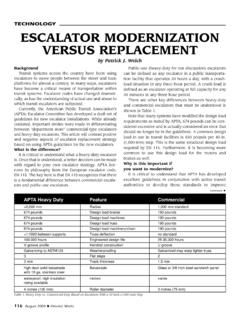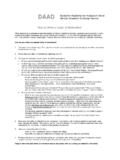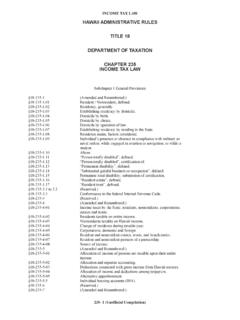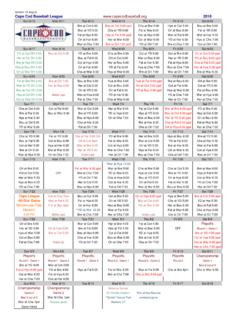Transcription of Elevator Guidelines for Emergency Generators - VTX
1 March 1998 Elevator World45 Passengers trapped in elevators need every opportunityto escape an Emergency situation. If designed to operate onstandby power, the Emergency generator must operate ele-vators safely and reliably. If the elevators do not operateproperly while on Emergency power, seri-ous consequences can most commonly ignored operation ofan Elevator is its ability to operate properlyon standby power. The American Society ofMechanical Engineers (ASME) andmost local codes require Elevator standbypower testing annually, with no-load andfull-load (125% of capacity) test every fiveyears. Furthermore, if more than one eleva-tor is capable of running simultaneously,they shall be tested shows that many buildingsignore this code requirement.
2 Some large fa-cilities, including hospitals, have not testedany of the elevators on Emergency power inover 20 years! With the advent of SCR andVFAC drives for elevators and other devices,existing Emergency Generators are often notcapable of providing the proper power to op-erate the elevators in an in mind that older Elevator sys-tems often do not operate at the originalcontract speed. Therefore, if any equipment has been addedsince the original installation, the change to a solid-statedrive operating at the proper speed can cause unpredictableproblems. Additionally, older Emergency Generators have adifficult time with the rapid changes in current demand thatsolid-state drives and voltage harmonics also differ greatly fromutility power to the Emergency generator power grounding methods and increased impedanceof the generator system can cause additional problemswith sensitive devices on the Emergency bus, due to in-creased harmonics and tests with the Reliable Power Meter monitorhave determined that existing generator or Emergency feed-ELEVATORGUIDELINESFOREMERGENCYGENER ATORSby Patrick J.
3 Welchers must be upgraded to operate with an adjustable-speedelevator solid-state drive. Each test conducted followedASME establishing a benchmark on utility power, the gen-erator was started, and a powerloss was mimicked at the trans-fer switch. While on emergencypower, the quality of power wasmeasured as defined here: frequency; total harmonic distortion(THD) for current and RMSvoltage; RMS voltage; and comparing utilitypower quality to the emergencygenerator power, the quality ofpower with no load was deter-mined. The load on the elevatorwas then increased until 125%of rated capacity was reached,as required by MODERNIZATIONI ndicates an Online Featureaa46 March 1998 Elevator WorldThe most common problems operating on emergencypower discovered to date have been:1.
4 Increase in THD, up to a 300% increase over util-ity power;2. Improper or inadequate grounding methods;3. Poor voltage regulation (>25%); and4. Voltage sags in excess of solid-state drive our testing program was started in February 1997,roughly one Syska & Hennessy existing building projectper month has required significant upgrading of the emer-gency generator and/or Emergency feeder, if a modernsolid-state Elevator drive is desired. Often, the client isunprepared for the additional expense of upgrading theemergency generator, and motor generator Elevator driveshave to be specified to save the client the Emergency gen-erator upgrade costs, as well as the potential disaster ofa failed Emergency help prevent problems, a conservative course ofaction developed through research, testing and feedbackfrom knowledgeable clients and vendors is does not mean that you cannot specify outside thesuggested parameters.
5 It does mean, however, that youmust be careful and should thoroughly investigate existingconditions to predict the effect of all of the various typesof drives on the Emergency potential problems of concern include:1. What other devices are operating on that emer-gency bus? UPS systems? VFD for fire pumps?2. Are other harmonic-rich devices on the same bus?For example, electronic ballast light fixtures the harmonicsof which can create problems for Are harmonic-sensitive devices such as radio ortelephone dispatching equipment or critical computerequipment on the same Emergency bus?4. Can the Emergency generator handle the choppedwaveform of regenerative power from the Elevator SCRwithout affecting its performance?
6 5. Is the voltage regulator for the Emergency generatordesigned for the worst-case scenario, as the code requires?Keep in mind that several different types of elevatordrives are in use today, including: Six-pulse SCR drives (typically filtered to 5% THD); 12-pulse SCR drive (no filter); Variable frequency/variable voltage AC (nonregen-erative); Variable frequency/variable voltage AC (regenerative) rare but increasingly more common; Motor generator set; and Across the line and WYE delta (hydraulic and rack& pinion).It is recommend that the Emergency generator specifi-cationsbe coordinated with the exact Elevator drive to beused on the ElevatorsIt is recommended that hydraulic elevators not be puton the Emergency generator unless they are critical hos-pital patient care elevators that will need to be usedthroughout the power outage.
7 It is far more efficient toprovide an Emergency -battery lowering device on theseelevators to rescue the passengers instead of including alarge horsepower motor on the Emergency generator justto allow passengers one trip to get out of the Emergency GeneratorsDo not design more than two elevators equipped withsolid-state drives to run on the same Emergency bus simul-taneously. Research and field testing reveals that the har-monics and regenerative nature of most Elevator drives cancause voltage distortion problems on the same bus. Do notallow adjustable-speed solid-state drives of any type to ex-ceed 50% of the capacity of the Emergency generator. Thisincludes other solid-state drives in the building that will beusing the same Emergency power circumstances require a greater than 50%drive capacity of the Emergency generator, ensure thatthe generator manufacturer is aware of the type andquantity of the drives.
8 Serious consideration should begiven to specifying the allowable voltage distortion. Ifthere is an overall voltage distortion limit, make sure thatthe generator unloaded waveform is well below thatlimit. It is virtually impossible to filter an inherently dis-torted generator BuildingsCheck the governor/regulator of the Emergency gen-erator; older buildings being renovated often have me-chanical governors on the Emergency Generators . Mod-ern solid-state drives simply cannot operate properlywith the voltage distortion created by a solid-state drivePhase C RMS Voltage Aug 15, 1997 10:20:5730027024022020010:00 August 15, 1997 Phase C RMS Voltage Aug 15, 1997 11:04:4430027024022020011:21 August 15, 1997 Figure 1: Utility power during full load runs of Elevator ;Voltage fluctuation is less than 6 2: This is the same Elevator on Emergency voltage fluctuation is up to 40 Guidelines ContinuedMarch 1 9 9 8E levator World4 7and an Emergency generator with a mechanical gover-nor.
9 Keep in mind that Elevator drives move people, notfans or computers, and the operating tolerances aretight. Simply put, rarely is it recommended to allow anelevator with a solid-state drive to operate on an emer-gency generator without a solid-state regulator being in-stalled on the Emergency example, Figures 1 and 2 show a graphic expres-sion of the quality of the voltage of an Elevator systemwith a motor generator drive while on utility power duringa full-load weight test of the elevators. Had solid-statedrives been utilized, the Emergency generator or elevatorwould not have operated existing buildings should be properly tested to de-terminea final design.
10 The test should not use a load is critical to determine what other sensitive devices operateon the Emergency generator. The load bank is simply tooclean (no reactance or interference) to properly determinehow the Elevator affects the maintenance contracts should define this re-quirement clearly. Experience shows that if the buildingdoes not require this test, the Elevator maintenance con-tractor will consider it a building manager's load bank is also too clean to determine if theelevator drive will affect other devices on the same emer-gency generator bus - items such as electronic ballastlights, fire control systems, radio dispatching centers andother communication "blackout" type test is recommended whenever pos-sible, so all concerned parties will understand which de-vice operates properly and which devices have difficultiesunder Emergency conditions.













